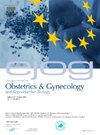高收入低生育和晚生育妇女的妊娠期体重增加和产后抑郁症状
IF 1.9
4区 医学
Q2 OBSTETRICS & GYNECOLOGY
European journal of obstetrics, gynecology, and reproductive biology
Pub Date : 2025-09-30
DOI:10.1016/j.ejogrb.2025.114746
引用次数: 0
摘要
目的探讨高收入“低生育和晚生育”妇女GWG与产后抑郁症状的关系,并将其合并为单一类别。方法采用爱丁堡产后抑郁量表(EPDS)对2,561名低危产妇进行了队列研究,从意大利阿巴诺特尔梅(Abano Terme)阿巴诺综合医院(Abano Polyclinic)产科病房出院前,基于孕前体重指数(BMI)类别和产后抑郁症状,研究了低生育能力和晚生育能力对GWG的影响。使用EPDS切断阈值>; 9和>; 12以及快感缺乏、焦虑和抑郁亚量表分别评估产后抑郁症状。结果中位年龄33.0岁(IQR: 30.0 ~ 37.0),胎次1.00 (IQR: 1.00 ~ 2.00)。与肥胖(5.19%)相比,孕前体重不足的患病率(8.71%)更高。此外,25.15%的参与者EPDS总分为9分,10.89%的参与者EPDS总分为12分。分析显示,孕前BMI与GWG类别之间存在显著的整体关联(p < 0.001),其中47.30%的人被归类为GWG足够,24.25%被归类为GWG不足,28.43%被归类为GWG过多。最后,GWG与EPDS总分升高(>;9或>; 12)或快感缺失、抑郁或焦虑亚量表得分升高的风险增加无关。结论高收入首次妊娠晚的女性,孕前体重过轻的发生率高于肥胖,可能导致GWG异常与产后心理情绪困扰之间缺乏相关性。本文章由计算机程序翻译,如有差异,请以英文原文为准。
Gestational weight gain and postpartum depressive symptoms in high-income women with low and late fertility
Objective
This study aimed to investigate the relationship between GWG and postpartum depressive symptoms among high income women with ‘low and late fertility’, combined into a single category.
Methods
We examined the impact of low and late fertility on GWG, based on pre-pregnancy body mass index (BMI) categories, and postpartum depressive symptoms, tested by the Edinburgh Postnatal Depression Scale (EPDS), in a cohort of 2,561 low-risk puerperae, prior to discharge from the maternity ward of Abano Polyclinic, Abano Terme (Italy). Postpartum depressive symptoms were evaluated separately using EPDS cut-off thresholds of > 9 and > 12, as well as the Anhedonia, Anxiety, and Depression subscales.
Results
The women had a median age of 33.0 years (IQR: 30.0–37.0) and a parity of 1.00 (IQR: 1.00–2.00). A higher prevalence of pre-pregnancy underweight status (8.71 %) was observed compared to obesity (5.19 %). Additionally, 25.15 % of the participants had EPDS total scores > 9, and 10.89 % had scores > 12. Analysis revealed a significant overall association between pre-pregnancy BMI and GWG category (p < 0.001), with 47.30 % classified as having adequate GWG, 24.25 % as inadequate, and 28.43 % as excessive. Finally, GWG was not associated with an increased risk of elevated EPDS total scores (>9 or > 12) or with higher scores on the Anhedonia, Depression, or Anxiety subscales.
Conclusion
In high-income women experiencing a late first pregnancy, the lack of association between abnormal GWG and postpartum psycho-emotional distress may be influenced by a higher prevalence of pre-pregnancy underweight status over obesity.
求助全文
通过发布文献求助,成功后即可免费获取论文全文。
去求助
来源期刊
CiteScore
4.60
自引率
3.80%
发文量
898
审稿时长
8.3 weeks
期刊介绍:
The European Journal of Obstetrics & Gynecology and Reproductive Biology is the leading general clinical journal covering the continent. It publishes peer reviewed original research articles, as well as a wide range of news, book reviews, biographical, historical and educational articles and a lively correspondence section. Fields covered include obstetrics, prenatal diagnosis, maternal-fetal medicine, perinatology, general gynecology, gynecologic oncology, uro-gynecology, reproductive medicine, infertility, reproductive endocrinology, sexual medicine and reproductive ethics. The European Journal of Obstetrics & Gynecology and Reproductive Biology provides a forum for scientific and clinical professional communication in obstetrics and gynecology throughout Europe and the world.

 求助内容:
求助内容: 应助结果提醒方式:
应助结果提醒方式:


